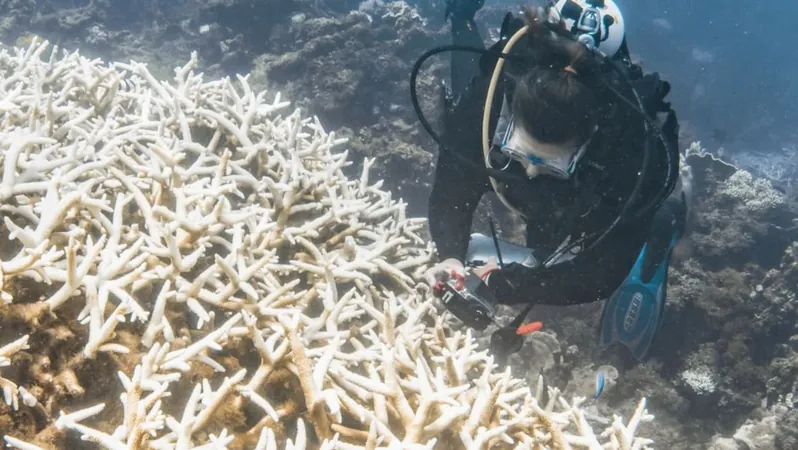
Australia's Reef in Distress: Unprecedented Bleaching Crisis Hits Ningaloo
2025-03-26
Author: Rajesh
Australia's Reef in Distress: Unprecedented Bleaching Crisis Hits Ningaloo
SYDNEY: A catastrophic mass bleaching event has devastated the Ningaloo Reef off Australia’s western coast, marking one of the most severe coral die-offs recorded in years. Scientists announced on March 26 that massive sections of this once vibrant reef have turned a dismal white, a stark indication of ecological distress.
Marine heatwaves have significantly worsened over the past months, severely impacting the diverse marine life that calls the reef home. "It's not just a surface issue; the bleaching has penetrated deep, affecting various coral species,” said Kate Quigley, an ocean scientist monitoring the alarming changes.
The Ningaloo Reef, recognized as a World Heritage site, spans approximately 300 kilometers and is famous for its thriving coral ecosystems and the migration of whale sharks. However, the region has experienced ocean temperatures reaching up to three degrees Celsius above average during recent summers, triggering what experts describe as an "unprecedented" response.
Quigley emphasized that the coral's reaction to warming waters is both alarming and concerning. “When the temperatures exceed the bleaching threshold, corals expel the colorful algae essential for their survival, leading to a condition akin to sickness that could result in death if conditions do not improve,” she explained.
The situation is particularly dire as this level of bleaching had not been witnessed since 2011. In addition to Ningaloo, isolated occurrences of coral bleaching have also been reported at the northern tip of the Great Barrier Reef on Australia’s east coast, signaling that the effects of climate change are being felt across the nation, albeit in different magnitudes.
Quigley pointed out that while the Great Barrier Reef has faced five mass bleaching events over the last eight years, this latest occurrence on the Ningaloo reef demonstrates the alarming universality of oceanic warming. “This is a critical moment; the warming is so intense that it's overpowering the specific local weather patterns,” she remarked.
In a broader context, global temperatures are now at their highest recorded levels for 2024, with a recent study indicating that extended periods of heat-related bleaching have impacted nearly 80% of the world’s coral reefs within just two years, from 2023 to 2024. A prominent UN report has warned that rising sea temperatures, coupled with issues like overfishing and pollution, pose an existential threat to coral systems worldwide.
Compounding these challenges, a recent study from the Australian National University highlighted that sea surface temperatures around Australia were the highest ever recorded. As Australia grapples with its rich natural resources, including coal and gas, there is growing recognition that the mining and fossil fuel industries contribute significantly to the climate crisis, resulting in more frequent heatwaves, bushfires, and droughts across the region.
The current plight of Ningaloo Reef serves as a chilling reminder of the ongoing climate emergency and its impact on one of the world’s most treasured ecosystems. Without immediate and comprehensive climate action, these vibrant underwater landscapes may face irreversible damage, challenging the very essence of marine biodiversity in Australia and beyond.


 Brasil (PT)
Brasil (PT)
 Canada (EN)
Canada (EN)
 Chile (ES)
Chile (ES)
 Česko (CS)
Česko (CS)
 대한민국 (KO)
대한민국 (KO)
 España (ES)
España (ES)
 France (FR)
France (FR)
 Hong Kong (EN)
Hong Kong (EN)
 Italia (IT)
Italia (IT)
 日本 (JA)
日本 (JA)
 Magyarország (HU)
Magyarország (HU)
 Norge (NO)
Norge (NO)
 Polska (PL)
Polska (PL)
 Schweiz (DE)
Schweiz (DE)
 Singapore (EN)
Singapore (EN)
 Sverige (SV)
Sverige (SV)
 Suomi (FI)
Suomi (FI)
 Türkiye (TR)
Türkiye (TR)
 الإمارات العربية المتحدة (AR)
الإمارات العربية المتحدة (AR)